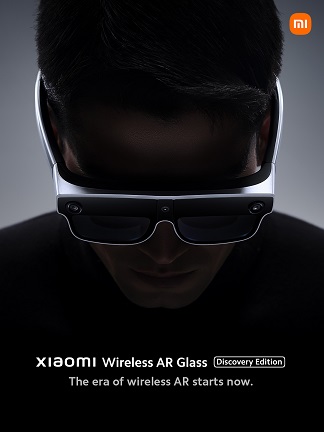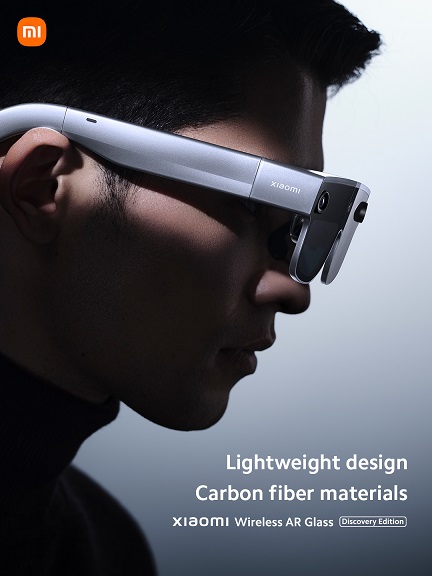Xiaomi, one of the world’s leading consumer electronics and smart manufacturing companies, today announced its brand new concept technology achievement, Xiaomi Wireless AR Smart Glass Discovery Edition, at Mobile World Congress 2023 (MWC 2023). This cutting-edge tech innovation is Xiaomi’s first wireless AR glasses to utilize distributed computing, offering a retina-level adaptive display that adjusts to the lighting environment. With enhanced connectivity to a Snapdragon Spaces ready smartphone, it enables innovative hand tracking at a refined level, supports a comprehensive range of applications for larger displays, and offers forward-thinking innovations in inter-device compatibility.
Wireless AR glasses, experience low latency with a cord-free design
Xiaomi Wireless AR Smart Glass Discovery Edition prioritizes individual experience. Weighing only 126g, it uses Xiaomi’s high-speed interconnection buses for wireless data connection to smartphones. Powered by Snapdragon® XR2 Gen 1 Platform with low-latency communication link, these Snapdragon Spaces™ XR Developer Platform-supported glasses achieve wireless latency as low as 3ms1 and full link latency as low as 50ms2, comparable to wired solutions.
The smart glasses are lightweight, weighing only 126g, and feature magnesium-lithium alloy, carbon fiber parts, and a self-developed siliconoxygen anode battery. They have been calibrated precisely by analyzing tens of thousands of head tracking data samples, considering factors such as center of gravity, leg spacing, angle, nose rest, and more for a superior experience.

Retina-level near-eye display for AR glasses, support for electrochromic color change passthrough shading via one key switch
At Xiaomi, our engineers believe that achieving the seamless integration of the digital and real-world requires users to perceive virtual objects as vividly and clearly as physical objects. To meet this need, the device must offer display quality of the highest caliber.
Xiaomi Wireless AR Glasses are amongst the industry’s first to achieve a retina-level display. As with high-end display concepts, there exists a critical value quality threshold for AR glasses. When angular resolution or PPD (pixels per degree) approaches 60, the human eye cannot distinguish granularity. The PPD of the Xiaomi Wireless AR Glasses is 58, which is the industry-leading closest to meeting this quality specification.
Xiaomi’s Wireless AR Glass utilizes a free-form optical module with a pair of MicroOLED screens and free-form light-guiding prisms for clear picture display. The prisms perform complex light refraction in a limited volume, reflecting content displayed on the screen on three surfaces and presenting it in front of the user’s eyes.
The smart glasses have an optical module design that minimizes light loss, producing clear and bright images with a to-eye brightness of up to 1200nit for strong AR applications. They also have electrochromic lenses that adapt to different lighting conditions, offering a blackout mode for immersive content and a transparent mode for a vivid AR experience that blends reality and virtual elements.
Xiaomi AR Gesture Control, a more natural way to interact
Xiaomi Wireless AR Glass also features an innovative self-researched micro gesture interaction that enables one-handed, highly-precise pure gesture interaction. This kind of interaction showcases one of the directions that Xiaomi believes human-computer interaction will take in the future.
Xiaomi’s Wireless AR Glasses use the joints of the user’s inner fingers as a gesture recognition area, with the second joint of the middle finger representing directional orientation and the second joint of the index finger representing upward direction. This forms a four-way directional key for basic movement operations. The 12 knuckles function similarly to the Chinese nine-key input method, allowing for text input through thumb tapping in the finger area, while thumb sliding on the index finger is used for entering and exiting applications. Xiaomi plans to enable sliding and tapping operations through the random movement of the thumb in the palm in the future.
Micro gestures on Xiaomi Wireless AR Glass enable users to perform daily app usage operations such as selecting and opening apps, swiping through pages, and exiting apps to return to the start page, all without using a smartphone for controls.
Xiaomi Wireless AR Smart Glass incorporates a low power-usage AON camera that enables prolonged gesture interaction and facilitates features. Furthermore, users can also opt for conventional smartphone controls, which can be paired and used as a gesture or touchpad control.
Bringing a new and more connected experience to AR glasses
Xiaomi’s extensive experience in cross-device interconnection has resulted in numerous innovative interconnection experiences being incorporated into wireless AR glasses.
The device enables large-screen apps via Mi Share’s streaming feature, optimizing display area usage for popular apps like TikTok and YouTube. With AR capability, users can place apps anywhere and adjust interface size via spatial gestures, enhancing info access efficiency and experience.
As the world’s largest smart home platform, Xiaomi integrates AR for a unique experience. The Wireless AR Glass “grabs” screencasts for viewing on the glasses. Users can operate smart devices through AR scenes, like turning a lamp on/off via spatial gestures. Spatial audio links virtual speakers with the real environment.
Xiaomi Wireless AR Smart Glasses Discovery Edition requires pairing with Xiaomi 13 or other Snapdragon Spaces ready device. The glasses are available in a titanium-colored design and support three sizes of nosepieces. Nearsighted users can use an attachable myopic clip. In terms of software support, the glasses are compatible with Qualcomm Snapdragon Spaces, OpenXR, and Microsoft MRTK development framework. Xiaomi intends to work closely with developers to expedite the arrival of AR.
- Data tested by Xiaomi Internal Labs. Actual results may vary according to device settings, usage conditions, and other factors.
- Data tested by Xiaomi Internal Labs. Actual results may vary according to device settings, usage conditions, and other factors.
Snapdragon and Snapdragon Spaces are trademarks or registered trademarks of Qualcomm Incorporated. Snapdragon and Snapdragon Spaces are products of Qualcomm Technologies, Inc. and/or its subsidiaries.



